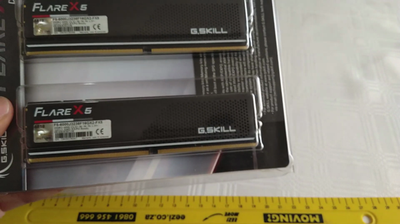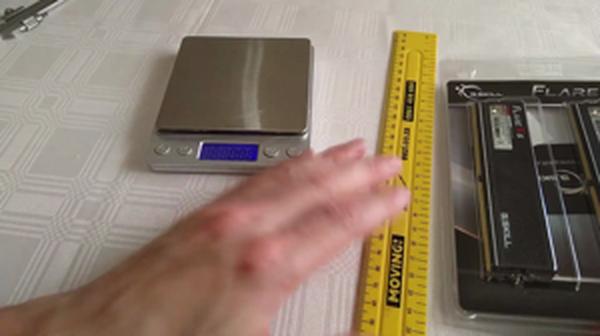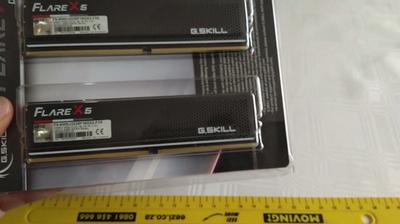
Trying out the G.SKILL Flare X5 DDR5 32GB 6000MT/s CL32 RAM (2024)
My thoughts on G.SKILL Flare X5 DDR5 32GB memory: Performance, design, stability, and overall verdict.
Introduction
I recently upgraded my PC with the G.SKILL Flare X5 DDR5 32GB memory and I've had some time now to thoroughly test its performance and compatibility. This memory has brought some notable improvements to my system, especially with its fast DDR5-6000 speeds and the convenience of AMD's EXPO profiles for simple overclocking. However I've run into a few hiccups, particularly regarding compatibility with different motherboards.
Some photos (click to enlarge)




Specs of the G SKILL Flare X5 DDR5 32GB 6000MT/s CL32 Matte Black
- Release Year
- Brand
- Compatible Devices
- Computer Memory Size
- Memory Speed
- Ram Memory Technology
Prices
Performance and Compatibility

When it comes to the G.SKILL Flare X5 DDR5 memory, I've got a mixed bag of experiences that mostly lean towards the positive side. Here's a quick rundown of what stands out to me in terms of performance and compatibility:
Fast speeds: The advertised DDR5-6000 speeds are incredible on paper and, when operational, provide a noticeable performance boost.
EXPO profiles: The AMD EXPO technology makes overclocking straightforward, which is a big plus for enthusiasts.
Compatibility: These sticks are designed for the latest AMD platforms, which ensures great synergy with Ryzen 7000 series CPUs.
Non-ECC: While these aren't ECC memory, they're still quite reliable for gaming and high-performance tasks.
Now, let's delve into a bit more detail. Out of the box, the Flare X5 DDR5 slotted into my system without any hiccups. On my MSI B650 motherboard, I initially ran into some troubles booting after enabling the EXPO profile, which was frustrating. However, after a BIOS update, I was glad to see the modules stable at 6000MHz. This is a testament to how newer technology, including BIOS updates, can significantly affect memory compatibility and stability.
However, not everything was smooth sailing. I also faced challenges trying to run the memory at its rated speed on an ASUS motherboard, suggesting that compatibility isn't universal. It's worth noting the memory defaults to a JEDEC profile of 4800MHz, not the higher advertised speeds, which are only achievable with EXPO enabled. This is important to keep in mind, especially for those who might mistakenly expect 6000MHz right out of the gate.
In terms of design, the low-profile and non-RGB sticks fit nicely with my build theme—though that's something I'll dive into more in a different section of the article. As for running four sticks, beware that achieving max speeds with a full house of 128GB may be a creative challenge due to the ongoing development with DDR5 technology.
Although the memory is quite impressive, some may find it pricey, which is a common concern for cutting-edge tech. I also noted during some heavy gaming sessions, the temps could reach around 50°C—not excessively hot, but something to monitor if you're pushing your system hard.
Overall, the G.SKILL Flare X5 DDR5 memory has its clear advantages with fast speeds and easy overclocking capabilities, particularly if you're on an AMD rig. The main drawbacks are concerns around initial compatibility and stability, which seem to be ironing themselves out with subsequent BIOS updates and continual development. If you're building a new system or upgrading to Ryzen 7000 series CPUs, these could be a valuable addition to your hardware lineup—just be prepared for potential teething issues as you push for those high-speed margins.
Design and Aesthetics

The G.SKILL Flare X5 DDR5 memory has caught my eye not just for its specifications, but also for its design aesthetics that complement a high-performance build. Here's a quick rundown of what stands out for me:
Sleek Form Factor: The matte black finish and minimalistic design with racing stripes are a breath of fresh air from the typical RGB-infused memory modules. This subdued look fits seamlessly into my all-black PC build, giving it a professional and clean appearance.
Compatibility with Large Coolers: The low-profile of just 33mm is a significant advantage, ensuring it doesn't clash with my hefty CPU cooler. This is an essential consideration for anyone who uses large air cooling solutions or has a compact PC case.
However, I wouldn't say that everything about the Flare X5's design is perfect. A possible drawback is the relative simplicity of the design, which might not appeal to everyone, especially those who prefer a more flashy or distinctive look to their components.
From a practical standpoint, I appreciate that these modules aren't just about aesthetics—they deliver performance and efficiency. While I initially had concerns about their EXPO instead of XMP profile, I found they ran impressively well even with my non-AMD setup, showcasing a degree of versatility I didn't expect.
If I were to critique anything else, it would be that the memory's default operation at SPD speeds may catch some users off guard. Remember, to take full advantage of the higher clock speeds, you'll need to enable the EXPO profile in the BIOS.
Overall, the G.SKILL Flare X5 DDR5's design and aesthetics are a solid plus for my personal setup. The modules are unobtrusive, look great, and offer a refreshing departure from the flashiness that has become the norm with modern gaming components. What it lacks in flair, it makes up for with its low-profile design that caters to a wide range of systems and the inclusion of performance-enhancing features like AMD EXPO for overclocking capabilities.
Those looking for a performance memory kit that keeps a low profile, both physically and visually, would do well with the Flare X5 series. It's the kind of hardware that blends in while helping the rest of your system stand out, meeting the aesthetic and functional needs of users who prioritize a clutter-free and efficient workspace.
Stability and Overclocking

When it comes to building a PC, the stability and overclocking capabilities of its components play a significant role in overall performance. The G.SKILL Flare X5 DDR5 memory is no exception. It's engineered to pair with the latest AMD Ryzen platforms, and besides its impressive default speeds, it features AMD's EXtended Profiles for Overclocking (EXPO), which paves the way for easy tuning via the BIOS.
Here's what I've found working with the Flare X5 series:
Memory kits boot at the SPD speed at default BIOS settings, ensuring a baseline compatibility.
The EXPO profiles are a game-changer, as they promise a seamless overclock to reach peak performance speeds - with the right hardware, of course.
Achieving the rated EXPO speed can be hit or miss, depending on the motherboard and CPU's prowess.
Yet, with performance potential comes caution. I've encountered that not all motherboards play nice with EXPO out of the gate. For instance, there were instances where my system wouldn't boot post-EXPO enablement, whipping me into a frenzy of CMOS resets and BIOS troubleshooting.
Despite these occasional hiccups, the Flare X5's stability at default speeds is unquestionable. This RAM kit is consistent with typical G.SKILL reliability—an aspect many users, including myself, value highly.
However, reach for the stars with overclocking, and you might catch some turbulence. The RAM's stability at higher speeds—such as the advertised 6000 MHz—isn't guaranteed and may depend on factors like BIOS maturity and compatibility nuances.
One thing's for sure: ensuring that you have the latest BIOS version can make a world of difference. A stable BIOS update can turn a non-EXPO booting system into an overclocking marvel that holds up under strain.
Here are some points that stand out from my experience:
Overclocking to achieve the maximum advertised speed isn't always straightforward.
Stability is heavily influenced by the motherboard-CPU-RAM synergy.
High temperatures under load can introduce instability, particularly at EXPO speeds.
Through various forums and my own testing, I've learned that these modules perform best when housed in a system that's EXPO-friendly, preferably with a Ryzen 7 or higher and a motherboard whose manufacturer keeps its BIOS tightly on point. Even then, expect to roll up your sleeves and be prepared for a tinkering session or two to get the settings dialed in just right.
While the G.SKILL Flare X5 might present a mild learning curve for enthusiasts dipping their toes into memory overclocking, its high-quality ICs and compatibility with the latest platforms suggest a future-proof investment. The potential performance boost is enticing, and if your PC build checklist includes AMD's Ryzen 7000 series or newer, you're looking in the right place. Just keep in mind, it's not quite a plug-and-play affair—you've been forewarned!
Final Verdict

After putting the G.SKILL Flare X5 DDR5 memory through its paces, I've landed on a cautiously optimistic final verdict. It's no secret that diving into the latest DDR5 technology can be hit or miss due to its relative newness and compatibility issues. However, the Flare X5 Series presents a compelling case with its premium specs tailored for enthusiasts and gamers.
Here's my takeaway:
Pros:
Excellent performance: When the EXPO profiles work as intended, the speeds hit the 6000 MT/s mark without a hitch.
Aesthetics: The minimalistic, no-RGB design makes these sticks stand out in a sleek build.
Low profile: Their height is great for builds with larger CPU coolers or small form factors.
AMD EXPO support: Easy to configure for those with compatible AMD setups.
Cons:
Compatibility issues: Not every motherboard plays nice with these sticks, particularly at their advertised speeds.
EXPO vs. XMP: Intel users might face hurdles since these are geared towards AMD architectures.
I bought these sticks mainly for their advertised speed and AMD EXPO compatibility. I was impressed with the sleek design, and once they were installed, I had no trouble appreciating the neat look they brought to my tidy, black-themed rig. The low-profile aspect is particularly appealing since it avoids clearance issues with my cooler.
Performance-wise, when the setup runs smoothly, it's a dream. I saw my apps and games load faster, and my system handled multitasking without breaking a sweat. The leap from my older DDR4 kit was evident from the get-go.
That said, the journey wasn't without turbulence. Initially, the EXPO profiles caused instability in my system, and I had to default to the slower SPD speeds to maintain system stability. It felt like a bit of a gamble—after all, you buy high-speed RAM to actually use it at those speeds. Thankfully, a BIOs update eventually smoothed things out, and I ultimately got what I paid for.
Still, I've heard and read about others not being so lucky, with persistent stability issues even after troubleshooting. Memory compatibility can sometimes feel like you're at the mercy of a BIOs lottery, which can be frustrating.
For those on the Intel side of the fence, these sticks might seem less attractive given the focus on EXPO, but don't write them off completely. Incompatibility is not synonymous with inferiority, and these modules have proven to work well, albeit with some manual tweaking required.
In conclusion, the G.SKILL Flare X5 DDR5 series offers high-speed, low-profile memory with the potential to elevate your system, provided your hardware ecosystem is compatible. A little patience may be in order for BIOS updates that will invariably improve stability, but the investment can pay off handsomely for the tech-savvy user. So, if you're building a new AMD-based system or looking to upgrade, these RAM sticks deserve a spot on your shortlist.
Comments (0)
Share